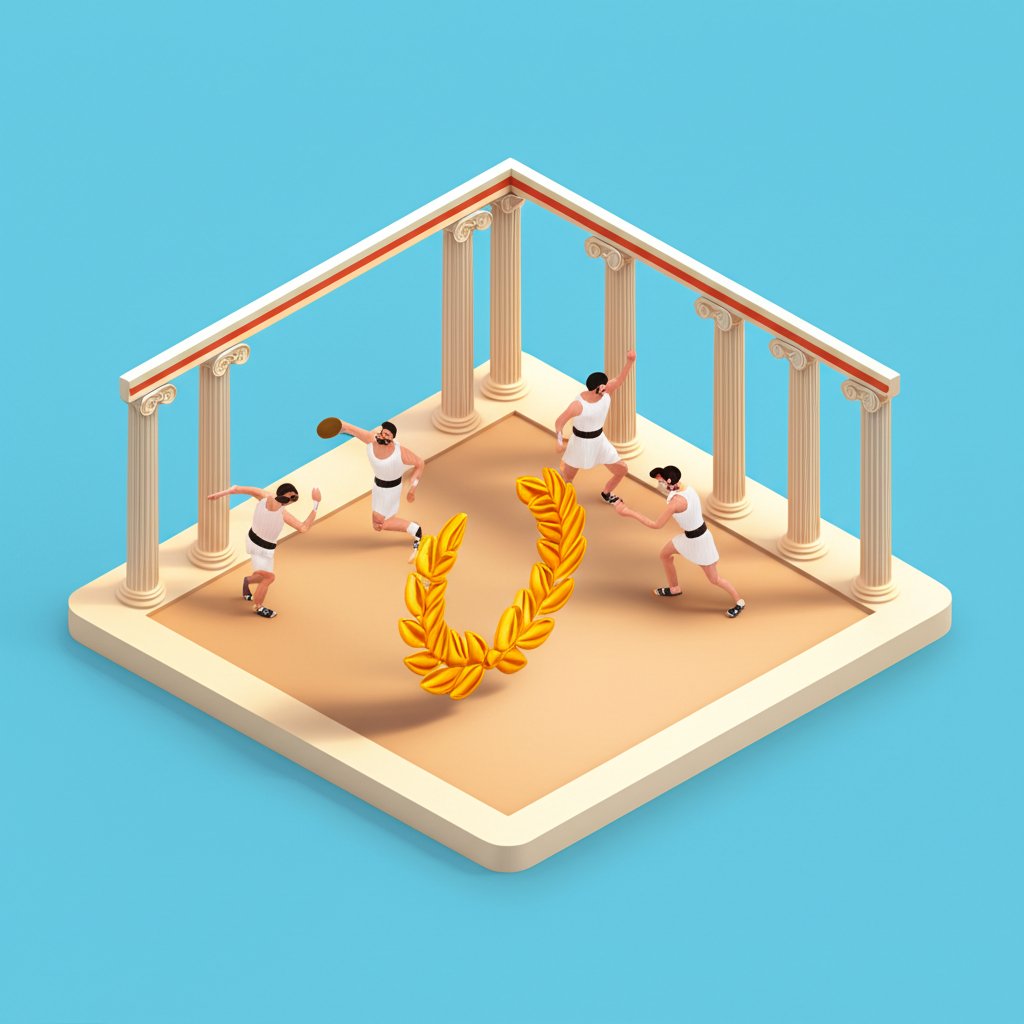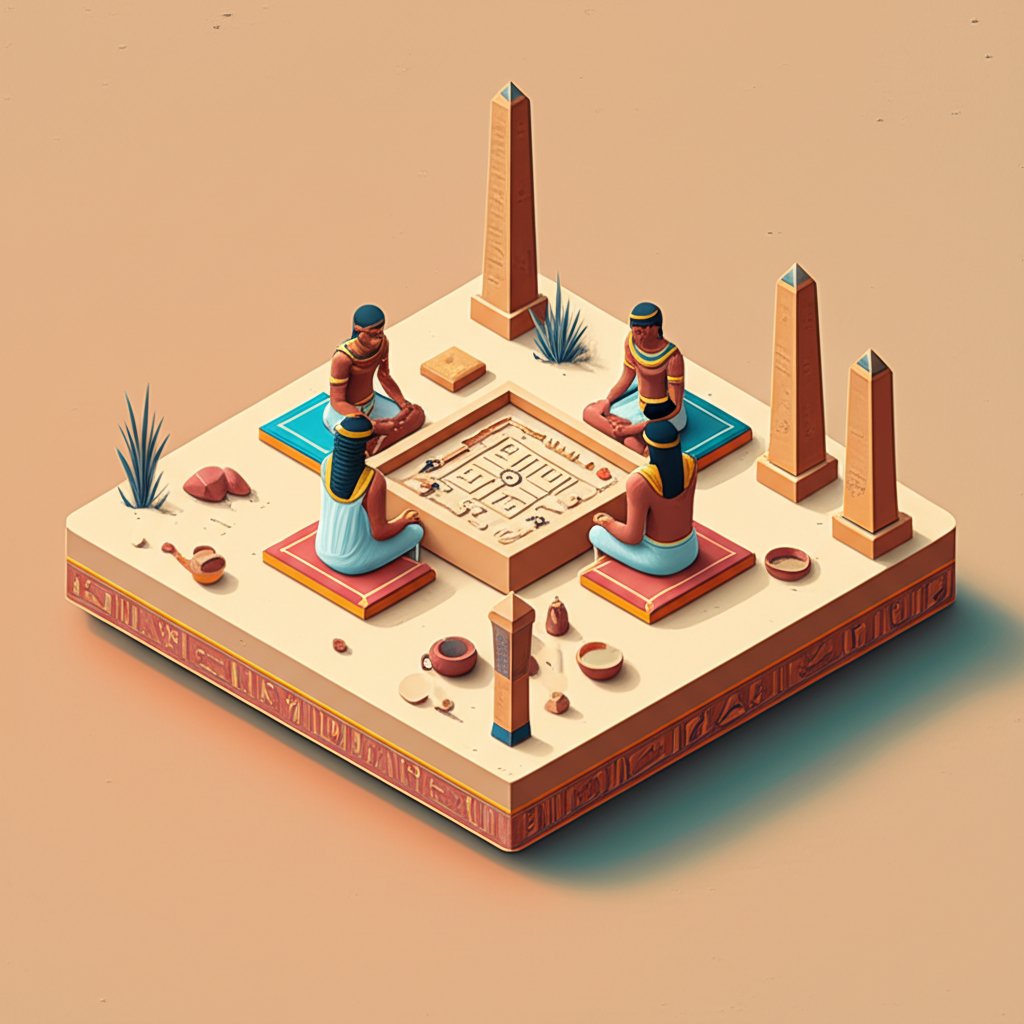Long before pixels flickered and consoles hummed, humanity’s fascination with play was already deeply ingrained. The origins of games are not found in silicon valleys or sprawling digital worlds, but in the sun-baked plains of Mesopotamia, the fertile banks of the Nile, and the bustling cities of the Indus Valley. These early pastimes, often simple in their construction yet profound in their cultural significance, reveal a captivating chapter in the broader history of gaming. Join us as we journey through time, uncovering the ancient games that shaped societies, challenged intellects, and laid the foundational strategies for the rich tapestries of play we enjoy today. This exploration will show how ancient civilizations cultivated a universal language of competition, ritual, and sheer enjoyment, revealing the enduring legacy of board games and other diversions from millennia past.
The Dawn of Play: Tracing the Ancient Origins of Games
The impulse to play is as old as humanity itself. Far from being mere frivolous activities, games in antiquity served vital roles, from fostering social cohesion and teaching strategic thinking to acting as conduits for spiritual beliefs and communal rituals. The earliest archaeological evidence paints a vivid picture of a world where play was an integral part of daily life.
Earliest Archaeological Evidence and the Urge to Play
The concept of formalized play, where rules and objectives guide interaction, emerged thousands of years ago. Archaeological findings from the Bronze Age, stretching across Europe, Egypt, and the Indus Valley, provide compelling evidence. Among the earliest known ancient games are simple tokens and marked stones, some dating back as far as 3500 BCE. These rudimentary pieces suggest that games might have evolved from basic counting systems or recording mechanisms, transforming practical tools into instruments of amusement and challenge.
The very origins of games stem from fundamental human needs:
Cognitive Stimulation: Games offer complex problem-solving, pattern recognition, and memory challenges. Social Interaction: They provide a structured environment for cooperation, competition, and communication. Emotional Expression: Play allows for the safe exploration of emotions like joy, frustration, and triumph. Cultural Transmission: Games often embed cultural values, stories, and historical narratives.This deep-seated human desire for play led to the spontaneous invention of diverse ancient games across every burgeoning civilization.
Exploring these ancient pastimes provides a fascinating backdrop when considering the broader timeline of how interactive entertainment has evolved, as detailed in this comprehensive look at the history of game design.
Global Crossroads: Ancient Civilizations and Their Gaming Heritage

The map of ancient games spans the entire globe, with each major civilization contributing unique forms of play. These games were not isolated phenomena but rather interconnected threads in the global history of gaming, often evolving and spreading as cultures interacted.
The Fertile Crescent: Birthplace of Strategy Board Games
The ancient Near East, often called the cradle of civilization, was a hotbed for the development of sophisticated board games.
The Royal Game of Ur (Mesopotamia, c. 2600 BCE): Discovered in the Royal Tombs of Ur, this elaborate race game involved dice (often pyramidal or tetrahedral) and counters, combining luck with strategic movement. Its beautifully inlaid boards signify its importance, possibly linking it to royalty or religious rituals. The game’s principles, including capturing opponents’ pieces and racing to a finish, are echoed in countless modern games. Senet (Ancient Egypt, c. 3100 BCE): Perhaps the oldest known board game, Senet translates to “passing” and was intimately linked with the Egyptian concept of the afterlife. Players moved pieces across a 3×10 grid, aiming to reach the end, symbolizing the soul’s journey through the underworld. Paintings of pharaohs like Tutankhamun playing Senet underscore its profound cultural and spiritual significance as one of the most revered ancient games. Mancala Games (Africa and the Middle East, c. 6th century CE, with earlier roots): While many variants exist, Mancala games (like Oware, Bao) are among the most widespread ancient games. These “sowing and reaping” games involve distributing seeds or stones into pits, often emphasizing mathematical skill, forward planning, and strategic resource allocation. Their deep presence across African and Middle Eastern cultures highlights their enduring appeal.From the Indus Valley to Imperial China: Asian Contributions to Ancient Games
Asia’s ancient civilizations were prolific innovators in the realm of games, particularly strategy-heavy board games.
Chaturanga (Ancient India, c. 6th century CE): Widely regarded as the precursor to modern chess, Chaturanga (‘four divisions of the army’) mirrored military strategy. Each piece represented a part of the ancient Indian army – infantry, cavalry, elephants, and chariots – with the king and minister as central figures. Its emphasis on logical thought and foresight made it a powerful intellectual exercise, marking a pivotal moment in the history of gaming. India also had a rich tradition of dice games, often woven into epic narratives. Pachisi (Ancient India, c. 4th century CE or earlier): A cross-and-circle race game, Pachisi (“twenty-five,” referring to the highest possible throw of cowrie shells serving as dice) was played on a cruciform board. It involved multiple players racing their pieces around the board, with elements of capturing and blocking. This game eventually traveled west and influenced popular modern games like Ludo and Parcheesi. Go (Ancient China, c. 2nd millennium BCE): Known as Wei-ch’i in China, Go is one of the oldest and most strategically complex board games still played today. Players aim to surround territory and capture opponents’ stones on a grid. Its deceptively simple rules lead to an astonishing depth of strategy, making Go a quintessential example of enduring ancient games that demand profound intellectual engagement. Liubo (Ancient China, c. 5th century BCE): Though its exact rules are lost, Liubo was a popular two-player board game often mentioned in ancient texts and depicted in Han dynasty tombs. It involved sticks (perhaps dice) and playing pieces on a distinctive 12-line board, suggesting a blend of chance and strategy.Mediterranean Minds: Greek and Roman Play
The classical ancient civilizations of Greece and Rome embraced games as integral to both leisure and intellectual development.
Petteia (Ancient Greece, c. 5th century BCE): A Greek game resembling modern checkers or draughts, Petteia (meaning “stones”) involved moving pieces on a grid, with the objective likely being to capture or block opponents. It showcased the Greek appreciation for spatial reasoning and tactical thinking. Ludus Latrunculorum (Ancient Rome, c. 1st century BCE): Often called “The Game of Little Robbers,” this Roman board game was a military strategy game similar to chess or checkers. Its rules are also largely lost, but descriptions suggest it involved moving pieces (soldiers) to “capture” enemy pieces by flanking them. It was a popular pastime among Roman soldiers and citizens, highlighting the strategic dimension of ancient games. Alea (Ancient Rome): A broad term for dice games, Alea was incredibly popular, often played for high stakes. Roman citizens, from emperors to commoners, indulged in games of chance, leading to laws attempting to regulate gambling. The simple act of rolling dice has a long lineage in the history of gaming. Athletic Games: While not board games, the Olympic Games in ancient Greece and gladiatorial contests in Rome also represent formalized “games”—physical competitions with rules, winners, and losers—that were central to their cultures and left an indelible mark on the concept of organized sport in the history of gaming.Beyond Eurasia, other ancient civilizations developed their own rich gaming traditions.
Mesoamerican Ballgame (Olmec, Maya, Aztec, c. 1400 BCE onwards): This ritualistic and often deadly sport was central to Mesoamerican cultures. Played with a rubber ball on specially constructed courts, it combined sport, spectacle, and religious ceremony, reflecting cosmic battles and sacrifices. This is a unique example of a collective, physical ancient game. Indigenous African Games: Beyond Mancala, many other ancient games were played across the African continent. These included various forms of tag, wrestling, and object manipulation games, deeply integrated into communal life and storytelling, underscoring the universal origins of games in human society.Beyond Entertainment: The Multifaceted Role of Ancient Games
Ancient games were rarely just about idle amusement. They were powerful cultural tools, woven into the fabric of daily life, education, religion, and social stratification across ancient civilizations.
Games in Education and Spiritual Life
From Plato’s philosophical musings on the importance of play in learning to the practical application of games in divination, their educational and spiritual roles were profound.
Plato’s View: The Greek philosopher Plato believed that play was not just a childish activity but an essential component of a child’s complete education, fostering virtues, practical skills, and a deeper understanding of the world. Educational ancient games presented complex concepts in an engaging and motivating way, enhancing retention and critical thinking. Divination and Ritual: Many ancient games, particularly those involving dice or other random elements, were used for divination or as part of religious rituals. The outcome of a dice roll might be interpreted as a message from the gods, or a game’s progress could symbolize a spiritual journey, as seen with Senet in Egypt.Social Bonds and Status Symbols
Games were crucial for building and reinforcing social structures.
Community Building: In villages and towns, simple ancient games fostered social interaction, strengthened community bonds, and provided shared experiences. From children’s games mimicking adult activities to communal board games, play brought people together. Symbols of Status: Elaborate board games like the Royal Game of Ur or luxurious versions of Senet were often found in the tombs of royalty and nobles. The craftsmanship and materials used in these games indicated the owner’s wealth and status, transforming a pastime into a potent symbol of power and prestige.Strategic Thinking and Warfare Simulation
Many ancient games, especially strategy board games, were essentially abstract models of conflict, providing a safe arena to hone decision-making skills akin to those needed in warfare or governance.
Military Training: Precursors to chess, like Chaturanga, explicitly mimicked military formations and tactics. Playing these games allowed leaders and strategists to practice complex maneuvers and anticipate opponents’ moves, making them invaluable tools for intellectual and military development. Problem-Solving: The intricate rules and open-ended possibilities of games like Go cultivated deep analytical thinking, requiring players to plan multiple steps ahead, adapt to changing circumstances, and manage resources effectively. This aspect of the origins of games showcases their role in developing human intelligence.The Enduring Legacy of Ancient Board Games Today
The echoes of ancient games reverberate through modern gaming, demonstrating a continuous, unbroken history of gaming that spans millennia. Many of the fundamental mechanics, strategic principles, and even the very games themselves have either survived or profoundly influenced today’s diverse gaming landscape.
Iconic Ancient Board Games That Still Captivate
Remarkably, several ancient games continue to be played and enjoyed worldwide, testament to their timeless design and strategic depth.
Chess: Directly evolved from Chaturanga, modern chess retains the core elements of military strategy and abstract warfare, challenging millions of players globally. Go: This ancient Chinese game continues to be intensely studied and played, particularly in East Asia, with its profound strategic complexity celebrated for its intellectual elegance. Mancala Games: Countless variations of Mancala are played across continents, from street corners to international tournaments, preserving a rich tradition of mathematical and strategic thinking. Royal Game of Ur: While not as widely played as Go or Chess, enthusiasts and historians have reconstructed its rules, bringing this ancient Mesopotamian game back to life for modern audiences. Backgammon: Thought to have roots in games like the Royal Game of Ur and other ancient race games, Backgammon is a prominent modern example of a game combining dice luck with strategic player choices.How Ancient Mechanics Shaped Modern Gaming
The foundational principles developed in ancient games are the building blocks of countless modern entertainment experiences, from board games to video games.
Dice Mechanics: The use of randomizers like dice, common in ancient Rome (Alea) and Mesopotamia (Ur), is a ubiquitous element in modern board games, role-playing games, and video games, introducing elements of chance and unpredictability. Movement and Capture: The core mechanics of moving pieces across a board and capturing opponents’ pieces, seen in Senet, Petteia, and Ludus Latrunculorum, are fundamental to games like Chess, Checkers, and even map-based strategy video games. Resource Management: Mancala’s “sowing and reaping” mechanics directly prefigure resource management systems found in complex strategy games, where players must cultivate and allocate resources effectively. Territory Control: The essence of Go, surrounding and claiming territory, is a central theme in many modern strategy games, from digital real-time strategy to area-control board games.From Sand Boards to Digital Screens: The Continuous History of Gaming
The leap from the physical board games of ancient civilizations to today’s virtual realms might seem vast, but the underlying human impulse remains constant. Whether moving carved pieces on a clay board or commanding avatars on a screen, players seek challenge, connection, and narrative. The history of gaming is a testament to human ingenuity in creating formalized expressions of play that reflect our deepest cultural values and our unending quest for diversion and mastery. The digital age has simply provided new mediums for these ancient desires, amplifying the reach and complexity of games, but never truly departing from their fundamental origins of games in the early civilizations.
Conclusion

From the sacred pathways of Egyptian Senet to the strategic battlefields of Indian Chaturanga, the ancient games of early civilizations offer a profound window into the human spirit. They were not mere pastimes but crucial elements of culture, education, religion, and social life. By tracing the origins of games through the ingenuity of ancient civilizations, we uncover the deep roots of a phenomenon that continues to captivate and challenge us today. The enduring legacy of these early board games and other forms of play reminds us that the quest for entertainment, competition, and intellectual engagement is a timeless human endeavor, making the history of gaming a vibrant narrative of our collective past.
FAQ
Q1: What are the earliest known ancient games and where were they discovered?
A1: The earliest known ancient games include simple tokens from the Bronze Age (around 3500 BCE) found in Europe, Egypt, and the Indus Valley. More complex board games like Senet (Ancient Egypt, c. 3100 BCE) and The Royal Game of Ur (Mesopotamia, c. 2600 BCE) are among the oldest fully reconstructed games with known rules.
Q2: Which ancient civilizations were most influential in the origins of games?
A2: Several ancient civilizations were highly influential. Mesopotamia and Ancient Egypt were pivotal for the development of early board games like Ur and Senet. India contributed significantly with games like Chaturanga (precursor to chess) and Pachisi. Ancient China developed complex strategy games such as Go. Greece and Rome also had their own popular strategy and dice games.
Q3: How did board games evolve from ancient to modern times?
A3: Board games evolved through cultural exchange and innovation. Ancient mechanics like dice rolling, piece movement, and strategy building were refined over centuries. Games like Chaturanga directly evolved into modern Chess, while others like Pachisi influenced games such as Ludo. The core principles of tactical thinking and chance from ancient games formed the bedrock for the diverse array of board games we play today.
Q4: What role did ancient games play in society beyond entertainment?
A4: Beyond entertainment, ancient games served multiple crucial roles. They were used for education, teaching strategic thinking, mathematics, and social skills. Many games had spiritual or ritualistic significance (e.g., Senet’s connection to the afterlife). They also functioned as social bonding activities, status symbols for the elite, and even abstract training tools for military strategy in ancient civilizations.
Q5: Are any ancient games still played today?
A5: Yes, several ancient games continue to be played in various forms today. Chess evolved from the ancient Indian game Chaturanga. Go, from ancient China, remains a globally popular and highly complex strategy game. Mancala games, with their roots in ancient Africa and the Middle East, are played worldwide in numerous variations. Some historical reconstructions of games like the Royal Game of Ur are also enjoyed by enthusiasts.












